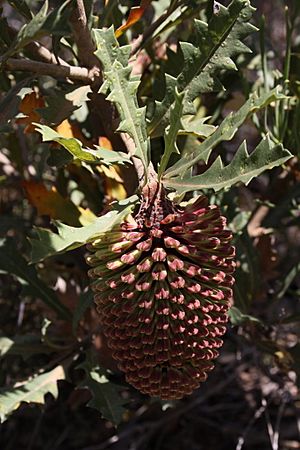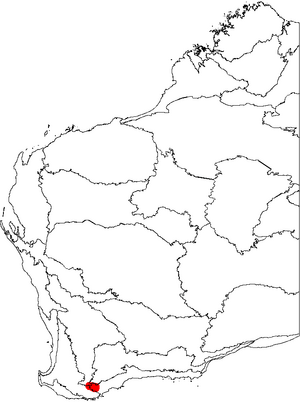Prickly banksia facts for kids
Quick facts for kids Prickly banksia |
|
|---|---|
 |
|
| Conservation status | |
| Scientific classification | |
| Genus: |
Banksia
|
| Species: |
aculeata
|
The Banksia aculeata, also known as the prickly banksia, is a special plant found in the Stirling Range in Western Australia. It's a type of shrub that can grow up to 2 meters (about 6.5 feet) tall. This plant has lots of leaves that are very prickly, like tiny saws.
Its flowers are quite unique! They are pinkish and hang downwards, unlike most other banksia flowers that stand upright. These flowers appear in early summer but are often hidden among the leaves. Even though people knew about this plant since the 1840s, it wasn't officially named until 1981 by a scientist named Alex George.
The prickly banksia is a rare plant. It grows in rocky soil in high places. This plant lives in areas where bushfires happen often. When a fire comes, the plant dies, but new plants grow from its seeds. It also seems to be somewhat resistant to a plant disease called Phytophthora cinnamomi.
Contents
What Does Prickly Banksia Look Like?
The prickly banksia is a bushy shrub that can reach up to 2 meters (about 6.5 feet) tall. It has grey bark on its trunk and branches. Unlike some other banksias, it doesn't have a woody base that helps it regrow after a fire.
Leaves and Flowers
Its leaves are about 4 to 9 centimeters (1.5 to 3.5 inches) long. They are quite wide and have very sharp, pointed edges.
The flowers appear in February and March. They are shaped like cylinders and are about 6 to 9 centimeters (2.5 to 3.5 inches) long. These flower spikes hang downwards from short branches. Each spike is made of many small, tightly packed flowers.
The individual flowers have a smooth, tube-like part called a perianth. This part is pink at the bottom and creamy white at the top, measuring about 3 to 4.3 centimeters (1.2 to 1.7 inches) long. Inside, there's a smooth part called a pistil, which is slightly shorter.
Seeds and Seedlings
After flowering, the plant forms a woody cone called an infructescence. This cone holds up to 20 large, oval-shaped seed pods called follicles. These pods are wrinkled and covered with fine hairs. They are about 3 to 4.5 centimeters (1.2 to 1.8 inches) long.
The seeds inside are flat and egg-shaped, about 4 to 5 centimeters (1.6 to 2 inches) long. They have a small plant embryo and a papery wing. The first leaves that grow from a seedling are wedge-shaped and dark green.
The Banksia caleyi looks similar to the prickly banksia. However, you can tell them apart because B. caleyi has leaves that curve downwards, and its flowers appear from October to December.
How Scientists Classify Prickly Banksia
The prickly banksia was first collected by James Drummond in the 1840s. But it wasn't until 1981 that Alex George officially described and named it Banksia aculeata. He chose the name aculeata because it means "sharp" in Latin, referring to the plant's prickly leaves.
Scientists group plants into categories to understand how they are related. Alex George placed B. aculeata with other banksias that have hanging flower spikes. He thought its closest relative was B. caleyi. They are similar but have differences in their leaves, flowers, and when they bloom.
Later, other scientists like Kevin Thiele and Pauline Ladiges used different methods to study banksias. Their studies also showed that B. aculeata and B. caleyi are closely related. More recent studies using DNA also support this close relationship.
Where Prickly Banksia Lives
The prickly banksia grows in the foothills of the Stirling Range in Western Australia. It lives at heights between 250 and 500 meters (about 820 to 1,640 feet) above sea level. It prefers gravelly, clay-like soils in areas with shrubs. The area gets about 600 millimeters (24 inches) of rain each year.
This plant is quite rare. Most groups of prickly banksia have fewer than 100 plants. Because it has small populations and grows in a limited area, it's considered rare. However, it's not currently listed as endangered because some groups are not in immediate danger. The Western Australian government lists it as "Priority Two – Poorly Known" flora.
How Prickly Banksia Survives
Like many plants in Western Australia, the prickly banksia is used to bushfires. Most banksia species react to fire in one of two ways:
- Reseeders: These plants die in a fire, but the fire helps release their seeds. New plants then grow from these seeds.
- Resprouters: These plants survive fires by regrowing from a special woody base or from buds protected by thick bark.
The prickly banksia is a reeseeder. It dies when there's a fire because it doesn't have thick bark or a woody base to regrow from. However, it stores its seeds in its cones, and these seeds are released only after a fire. This means that new plants grow quickly after a fire. It takes about three to four years for new plants to start flowering.
Scientists haven't seen what animals pollinate the prickly banksia. Its flowering time is short compared to other banksias. But its flowers appear when not many other plants are blooming, making it an important food source for animals.
Some reports said that B. aculeata was harmed by a plant disease called Phytophthora cinnamomi. However, a study in 2008 found that this disease did not directly affect the species. This means the plant has a very low risk of dying out from this disease.
Growing Prickly Banksia
The prickly banksia grows slowly. It usually takes five to six years for a plant to flower from seed. However, one plant was reported to flower in just three years in Victoria, Australia.
As a garden plant, its flowers are bright but don't last long and are often hidden. However, its new leaves and the woody seed cones are quite attractive. This plant can grow in different types of soil as long as the soil drains water well. It prefers full sun but can also grow in partial shade, though it might produce fewer flowers there. It can also handle light pruning.
Images for kids
See also
 In Spanish: Banksia aculeata para niños
In Spanish: Banksia aculeata para niños




